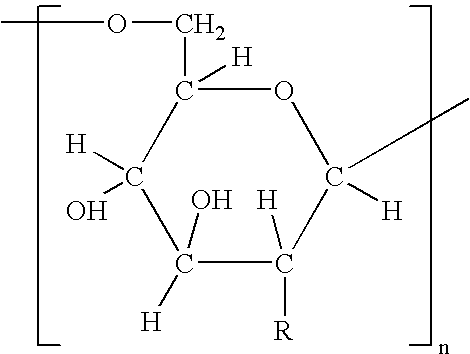Polysaccharide vaccine for staphylococcal infections
a polysaccharide and staphylococcal technology, applied in the field of polysaccharide compositions, can solve the problems of staphylococcal mastitis /i>is a common problem, staphylococcal mastitis to develop, and bacterial /i>bacteremia
- Summary
- Abstract
- Description
- Claims
- Application Information
AI Technical Summary
Benefits of technology
Problems solved by technology
Method used
Image
Examples
example 1
Purification of dPNAG
[0158] It has been discovered according to the invention that dPNAG can be produced from any bacterial strain expressing the ica locus. Specifically, these include Staphylococcus epidermidis, Staphylococcus aureus, and other Staphylococcal strains such as Staphylococcus carnosus transformed with the genes in the ica locus. The following specific strains can be used according to the invention to purify PNAG from include S. epidermidis RP62A (ATCC Number 35984), S. epidermidis RP12 (ATCC Number 35983), Staphylococcus epidermidis M187, S. carnosus TM300 (pCN27), S. aureus RN4220 (pCN27), and S. aureus MN8 mucoid.
[0159] The following is a method that can be used for producing dPNAG from Staphylococci containing the ica locus.
[0160] Starting material is prepared from cultures of Staphylococci expressing the ica genes by growing the bacteria as follows: The polysaccharide is prepared from 16 liter cultures of bacterial growth medium. A preferred medium is a chemica...
example 2
Preparation of dPNAG Diphtheria Toxoid (DTm) Conjugate Vaccine
[0164] DTm was covalently coupled to purified dPNAG by reductive amination. Aldehyde groups were first introduced onto the surface of diphtheria toxoid (DTm) by treatment of the protein with glutaraldehyde as described in step 1 below. Activated DTm was subsequently reacted with dPNAG, through its free amino groups in the presence of the reducing agent sodium cyanoborohydride as described in step 2 below.
[0165] Step 1: Activation of DTm with Glutaraldehyde
[0166] 10 mg of DTm (4.86 mg / ml solution in 20 mM HEPES buffer, 50 mM NaCl, pH 8) were dialyzed against 0.1 M carbonate buffer (pH 10) for 3 hours (h) at room temperature using a 10 kDa MWCO dialysis cassette. When the protein solution was completely exchanged with carbonate buffer, glutaraldehyde was added to a final concentration of 1.25% and the mixture stirred at room temperature for 2 h. This produced activated DTm, which was exchanged with Phosphate Buffer Salin...
example 3
Preparation of Native PNAG-DTm Conjugate Vaccine
[0170] Native PNAG (in this case, having 95%-100% acetate substitutions) was covalently coupled to purified DTm using the organic cyanylating agent 1-cyano-4-dimethylaminopyridinium tetrafluoroborate (CDAP) to activate the polysaccharide hydroxyl groups as described in Step 1 below. CDAP-activated PNAG was subsequently coupled to DTm as described in Step 2 below without the need for additional spacer molecules.
[0171] Step 1: Activation of PNAG with CDAP
[0172] 10 mg of purified PNAG were dissolved in 150 microliters of 5 M HCl, neutralized with an equal volume of 5 M NaOH and diluted up to 1 ml with borate buffer pH 9.2. CDAP was made up at 100 mg / ml concentration in acetonitrile and stored at −20° C. for up to 1 month. 200 microliters of CDAP (containing 20 mg) were slowly pipetted into a previously vortexed solution of PNAG-II (Maira, et al. Infect. Immun. 2002, 70: 4433-4440) in borate buffer (rapid addition of the organic co-solv...
PUM
| Property | Measurement | Unit |
|---|---|---|
| Fraction | aaaaa | aaaaa |
| Fraction | aaaaa | aaaaa |
| Fraction | aaaaa | aaaaa |
Abstract
Description
Claims
Application Information
 Login to View More
Login to View More - R&D
- Intellectual Property
- Life Sciences
- Materials
- Tech Scout
- Unparalleled Data Quality
- Higher Quality Content
- 60% Fewer Hallucinations
Browse by: Latest US Patents, China's latest patents, Technical Efficacy Thesaurus, Application Domain, Technology Topic, Popular Technical Reports.
© 2025 PatSnap. All rights reserved.Legal|Privacy policy|Modern Slavery Act Transparency Statement|Sitemap|About US| Contact US: help@patsnap.com



